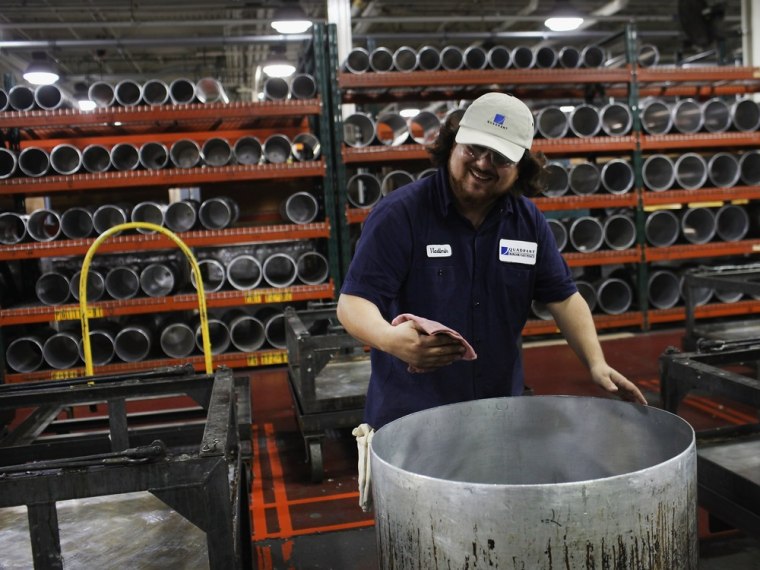Productivity growth is the elixir that makes an economy flourish. Best described as output per worker, productivity grows when workers harness innovation, machinery, experience and their own skills to produce more in less time. When that happens, historically, society prospers. Workers get paid more because companies are generating more cash and lowering expenses; governments raise more tax revenues because citizens and corporations are more prosperous, and more money is available for the research and education that will nurture the next round of productivity. The so-called productivity miracle of 1997-2003, which was boosted by heavy spending on technology, fostered rapid growth, decent wages and low inflation.
The crucial role productivity plays makes recent news all the more alarming. Worker output actually fell in the first two quarters of 2011, the first back-to-back decline since 2008, according to the Labor Dept.
Just as worrisome, the productivity gains that often occur at this stage of a recovery are far more anemic than originally estimated, and Labor Dept. economists have revised the data from 2007 to the present downward. Worker output per hour rose at a 2 percent annualized pace between the fourth quarter of 2007, when the recession began, and the first three months of 2011, according to the DOL revisions. The original estimate was 2.7 percent. Productivity for the foreseeable future will advance between 2 and 1.5 percent, well under the 3.4 percent pace set during the halcyon days of 1997 to 2003, say economists at the Federal Reserve Bank of New York.
Bloomberg Businessweek: Hope for American manufacturing — and maybe jobs
The probable culprits: less aggressive spending on new equipment and technology by companies uncertain of the future, and a shift of investment dollars overseas to take advantage of cheaper workforces in China, India and elsewhere.
Waning productivity growth sets the stage for slower income gains, fewer job opportunities and larger federal deficits in the U.S. “This is not good news amid already dim prospects,” said James Kahn, chair of the economics department at New York’s Yeshiva University and a former central bank economist who wrote about the deceleration on the New York Fed’s Liberty Street Economics blog. “An underlying trend of slow productivity growth has emerged, which means our baseline assumptions about economic growth may be a little too optimistic.”
A rise in worker efficiency of 1.5 percent a year would mean a U.S. gross domestic product of $17 trillion by 2016 before accounting for inflation, according to Kahn, who worked at the New York Fed from 1997 to 2008. That’s $2.3 trillion less than the Congressional Budget Office’s forecast of $19.3 trillion. The difference is more than five times the $420 billion in output the U.S. lost during the 18-month recession that ended in June 2009, according to Bloomberg News calculations.
Bloomberg Businessweek: U.S. investing: Are the best times over?
As productivity growth fades, it will be harder for companies to contain costs, according to Julia Coronado, chief North America economist at BNP Paribas in New York. Slower growth may stall a return to rising wages that boost consumer spending. Lower productivity could also trigger inflation, which makes hiring new workers less expensive, and sap corporate profits that propel stock values, she adds.
With productivity not pulling its weight, the government may also have to revisit many of its policies. “The economy can’t shoulder too heavy a burden, so you have to design policies very carefully that will produce the maximum benefit and help create or support industries that will be the growth engines of the future,” says Coronado.
The rapid productivity expansion in the 1990s made it “an awful lot easier to get the budget under control,” says Michael Hanson, a senior U.S. economist at Bank of America Securities-Merrill Lynch. The growth generated more revenue, and the annual budget deficit of $221 billion in 1990 became a surplus of $236 billion by 2000.
Bloomberg Businessweek: What countries — and their citizens — owe
The recent negative growth in productivity provides further proof that the boom in the 1990s and a burst of productivity growth in 2009 and 2010 “were more temporary than the start of a marvelous new age of invention,” Robert J. Gordon, a professor at Northwestern University in Evanston, Ill., said in an e-mail. Gordon is a member of the National Bureau of Economic Research committee that determines the start and end of recessions. Following the revisions, the probability that the U.S. is in a long period of low productivity growth has increased to 90 percent from 40 percent, according to research by Yeshiva University’s Kahn and Robert Rich, an economist at the New York Fed.
The model Kahn and Rich used shows growth in employee output probably remaining under 2 percent for the next five years. The slowdown indicates that estimates of the breadth of the U.S. fiscal problem may “turn out to be overly optimistic,” says Harvard University professor Dale Jorgenson. The Congressional Budget Office projects slightly higher output per hour in the same period, though nothing like the miracle years.
“It’s pretty clear at this stage that we are running under” forecasts and “are likely to continue to do so,” former Federal Reserve Chairman Alan Greenspan said on Sept. 21 in a discussion hosted by the New America Foundation in Washington. Because of the aging workforce and lower productivity, the congressional supercommittee charged with trimming the budget deficit by about $1.5 trillion in 10 years should cut as much as $6 trillion, he said. The U.S. needs another productivity miracle. It’s not at all clear how or if it will get it.
The bottom line: Because of waning productivity, the U.S. economy may reach $17 trillion in size by 2016, versus the $19.3 trillion projected earlier.
